Android Check In
The Check In transaction allows you to check-in the asset(s) that are currently checked out to a customer, employee, or vendor. There are two options to check-in the assets and they are
Check In allows you to check-in assets from an employee, customer, or vendor, and then all the checked-in assets can be viewed in the Summary screen. Also, in the summary screen, you can collect a signature and/or print a receipt.
Quick Check In can be used when you have many assets that you want to check in from different customers/employees/vendors without worrying about a receipt or a signature on each transaction. Quick Check In screen will allow you to check-in the asset directly. The screen will not have a summary screen or the option to collect the signature/ receipt.
Keep in mind that you can "pin" fields on this screen. For more information on pinning, refer Android Pinning Data topic.
Note:
- Make sure to enable the Capture Transaction Geo Location under settings to capture the Geolocation of the transaction operation.
- Group Widget in the Asset Tag field - The Group Widget is a dropdown button that will appear for the asset that has "Transact As Whole" feature enabled. The Group Widget on the transaction page supports the behavior of the Group on a Transaction screen. It always ‘remembers’ the Asset that was selected as well as the group(s) that the asset is in.
To Check In an Asset
- Tap on the Transactions > Check In.
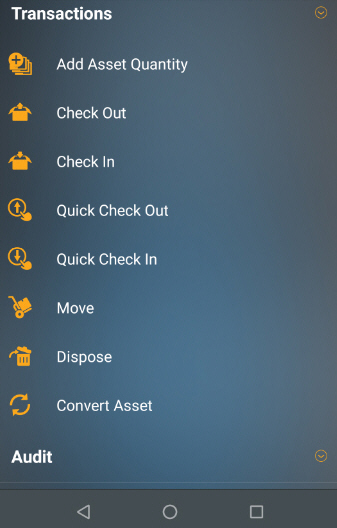
- The Check In screen will appear.
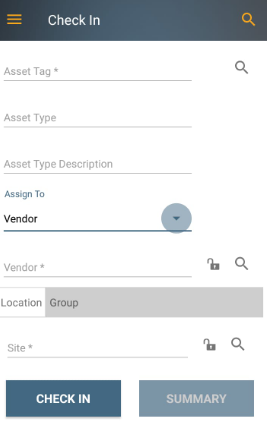
Note:
- If the Capture Transaction Geolocation under settings is enabled, then a pop-up message will appear asking the user to allow the application to access the device's location. Click on the Deny or Allow button.
- If you click on the Allow button, the application will enable the device's location feature and then this pop-up message will not appear again throughout the transaction operation.
- If you click on the Deny button, then the pop-up message wil again appear on CheckIn i.e when you click on the CheckIn button.
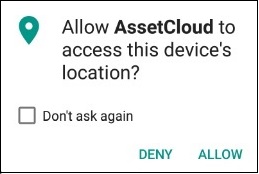
- Fields that are followed by an asterisk (*) are mandatory. Also, you can lock the field, refer to Android Pinning Data topic.
- The Magnifying Glass icon at the top of the screen navigates to the Search Asset Tags. The Magnifying Glass icon next to a particular field will navigate to the Search screen of that particular field. For example, the Magnifying Glass icon next to a location field will navigate to the search location screen.
- You can use the keyboard to enter the information in any field. Or if you want to scan a barcode, use the Barcode scanner. Tap on the Barcode symbol, the scanner will appear. Scan the barcode and the field will display the scanned barcode number. For Asset Tags, you can use the RFID feature. Refer to Radio-frequency identification (RFID) topic for more information.
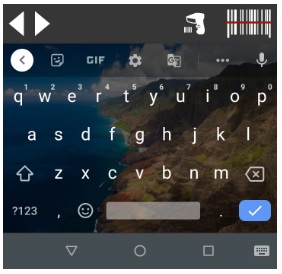
Asset Details & Location/Group Details
- Enter the Asset Tag or search for the asset in the search asset screen that you want to check-in.
- If the selected 'Asset' is in a group i.e. a child asset and "Transact as Whole" feature is enabled for the Group
- The asset tag field will automatically select the group (i.e. the parent) containing this asset. The Group Widget (dropdown button) will appear in the asset tag field and it will display the parent and the child asset. The View Group button will display all the grouped assets. Note that you can also select the child asset using the group widget. Example: Consider that HP Charger is a child asset for HP Laptop and Transact as Whole is enabled for HP Laptop. On selecting HP Charger, the asset tag will automatically select HP Laptop. Using the group widget, you can also select HP Charger.
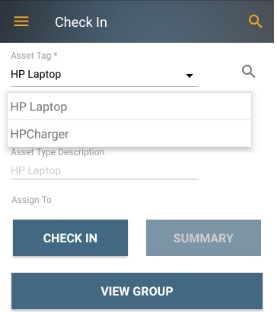
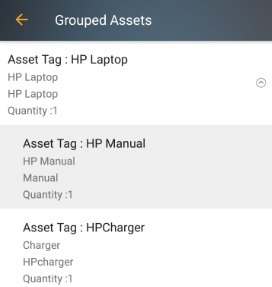
- If the selected 'Asset' is in a group i.e. a child asset and "Transact as Whole" feature is disabled for the Group
- The asset tag field will display the selected asset. The Group Tag field under Group tab will display the group name (i.e. the parent asset). Example - Consider that Flip Case is a child asset of Mobile. If you select Flip Case, since Transact As Whole is disabled for the Group (i.e.Mobile) containing Flip Case, the Asset Tag will display Flip Case and From Group will display Mobile.

- If the selected asset is a 'Group (parent asset)' and "Transact as Whole" feature is enabled for a group
- The asset tag field will select the whole group i.e. all the sub-items will be checked-in by default. if you want only the parent group to be checked-in, select the group with no sub-items from the dropdown. The View Group button will display the grouped assets.
Example: Consider that there are 3 groups - Container 1, Container 2, Container 3. Container 1 and Container 2 are Transact as whole.
If you select Container 1, the parent group i.e Container 2 with transact as whole feature enabled will get selected. Note that you can also select Container 1, Container 1 with no sub-items using the group widget.
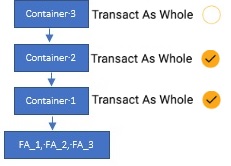
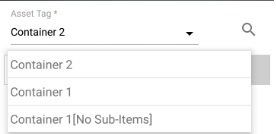
- If the selected asset is a 'Group (parent asset)' and "Transact as Whole" feature is disabled for a group
- The asset tag field will select the whole group.
Example: Consider that there are 3 groups - Container 1, Container 2, Container 3. Container 1 and Container 2 are Transact as whole. Container 3 is not transact as whole. So on selecting container 3, whole group gets selected. You can also select Container 3 with no sub-items. The View Group button will display the grouped assets.
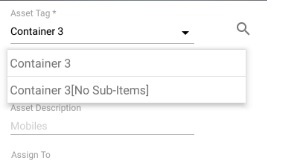
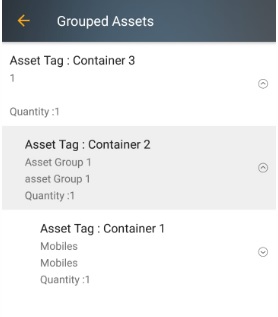
- The Asset Type, Asset Description, Site, Location, and Quantity will appear on selecting the valid Asset Tag. The Asset Type, Asset Description and Quantity will be read-only for a fixed asset. In the case of Multi-Quantity Asset, enter or select the Site, Location, From Group and enter the Quantity (Step 7 and 8).
- Select the Assign To. Assets can be checked-In to a customer, employee, or vendors. By default, the Assign To field will display Customer. This field will be a read only for fixed asset (This is also applicable when the asset tag is a part of a Group).
- Enter or search for the Customer/ Employee/ Vendors name.
- Location Tab
- Enter the Site. The Site can be added by clicking on the search button next to the field. Click on the search button, the screen will navigate to the Search Sites screen where you can search and add the Site.
- Enter the Location. The location can be added by clicking on the search button next to the field. Click on the search button, the screen will navigate to the Search Location screen where you can search and add the location. You can also add a new location by clicking on the '+' symbol on the Search Locations screen. Refer to New Location topic.
- Enter the Quantity.
- Group Tab
- From Group - Enter the From Group or click on the magnifying glass icon to access the Search Group Assets screen. Search for the group and tap on it.
- Enter notes, if required.
Custom Fields
- Fill all the Custom Fields.
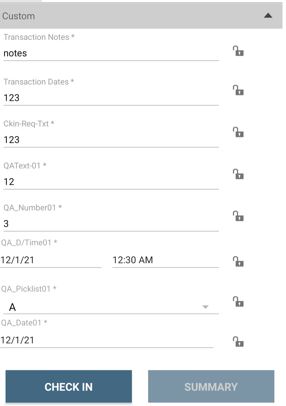
- Click on the Check In button.
- A message will appear indicating that the transaction is added.
- Once you tap on the Check In button, a number will appear over the Summary button. This is the number of transactions you have performed. You can keep adding quantity to different multi-quantity assets as needed.

- Click on the Summary button. The summary screen will appear. The summary screen will have details of each asset you have checked In. You can also uncheck the checkbox for the asset that you no longer want to check In.
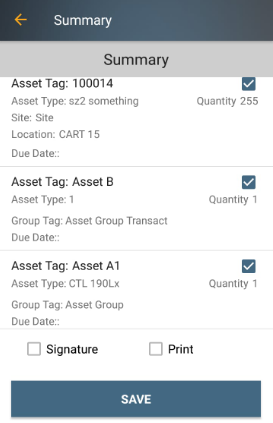
- Select the Asset and tap on the Signature checkbox and (or) Print checkbox. This step is optional. Click on the Save button.
Note: If the location permission is still disabled for the application, then on saving, a pop-up message will appear again asking the user to allow the application to access the device's location. Click on the Deny or Allow button. Once you click on the Allow button, the application will enable the device's location and then this pop-up message will not appear again throughout the transaction operation. But If you click on the Deny button, then the Geolocation will not get captured for this check-in transaction.
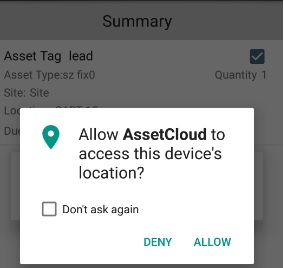
- If both the checkbox are selected, then on saving Signature screen will appear first and then Print options will appear.
- In the Signature screen, you can sign and save. Use Reset to clear the screen and sign again, Dismiss to close the Signature screen without signing.

- The Print option will appear after Signature. Select the print options - Bluetooth or Network and tap on the Print button. For information on printing from Android, please refer to the topic Printing from the Asset Cloud App.
- After collecting a signature and printing a receipt the session is closed and you will be returned to the Check-In screen.
















